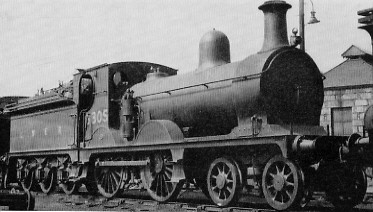The Manson D46 (GNSR Class N) 4-4-0 Locomotives

From its formation, the Great North of Scotland Railway (GNSR) purchased all locomotives from outside contractors. In 1887, an attempt was made to build two locomotives at the GNSR's Kittybrewster Works. The Kittybrewster facilities were very limited, and the main components were purchased from locomotive contractors. The GNSR did not attempt to build any further locomotives using its own facilities until 1909 when the modern Inverurie workshops were operational and it could build some of the D40s.
These two locomotives were similar to Manson's earlier Class G (LNER D48) locomotives. The driving wheels were one inch larger (5ft 7in diameter), and both the boiler barrel and firebox were lengthened. In many ways, this boiler was an intermediate step in GNSR boiler design. The new barrel length of 10ft 6in became a new standard, but the new 5ft 6in firebox would be extended to 6ft 0in in later locomotives.
The new locomotives became Class N, and the LNER would classify them as D46. They were also the first new GNSR engines to be named. Previous locomotives from absorbed lines often had names, but these had been removed by the GNSR. The names and their origins are listed at the bottom of this page.
Despite the use of a non-standard boiler, both D46s were reboilered with no significant modifications. No. 5 received a new boiler in April 1915, and No. 6 received a new boiler in August 1917. The new boilers had the same external dimensions and virtually identical heating surfaces to the old boilers. The most significant change, was the increase of the operating pressure from 140psi to 165psi.
Ramsbottom safety valves were initially fitted with seat casings. The GNSR eventually replaced the seat casings with column casings, and the LNER replaced the safety valves with Ross pop safety valves.
Both engines were usually allocated to Kittybrewster and they were used on a wide variety of duties. Typical duties included passenger and goods workings on both the main line and various branch lines, as well as ballast trains, and shunting duties. After Grouping (1923), they were usually confined to branch line or pilot duties. Occasionally they were seen at Kittybrewster sub-sheds such as Alford or Kintore. No. 6806 (GNSR No. 6) was withdrawn in 1932, and No. 6805 (GNSR No. 5) was withdrawn in 1936.
Technical Details
| Cylinders (x2): | (inside) | 17.5x26in. |
| Motion: | Stephenson | |
| Valves: | slide | |
| Boiler: | Max. Diameter: | 4ft 6in |
| Boiler: | Pressure: | 165psi |
| Diagram No.: | 89 | |
| Heating Surface: | Total: | 1159 sq.ft. |
| Firebox: | 100 sq.ft. | |
| Tubes: | 1059 sq.ft. (213x 1.75in) | |
| Grate Area: | 16.51 sq.ft. | |
| Wheels: | Leading: | 3ft 1in |
| Coupled: | 5ft 7in | |
| Tender: | 3ft 10in | |
| Tractive Effort: | (@ 85% boiler pressure) | 16,672 lb |
| Wheelbase: | Total: | 40ft 4.5in |
| Engine: | 21ft 2.5in | |
| Tender: | 11ft 0in | |
| Weight (full): | Total: | 71 tons 5cwt |
| Engine: | 42 tons 5cwt | |
| Tender: | 29 tons 0cwt | |
| Adhesive Weight: | 29 tons | |
| Max. Axle Load: | 15 tons |
Preservation
The last D46 was withdrawn in 1936, and none have survived into preservation.
Models
I am not aware of any models of the D46 in any scale.
Locomotives
These two locomotives were the first new locomotives to carry names on the GNSR. No. 5 was named Kinmundy after Chairman William Ferguson's residence near Mintlaw, and a name by which he was generally know. No. 6 was named Thomas Adam after the then Vice Chairman. The names were removed by Pickersgill.